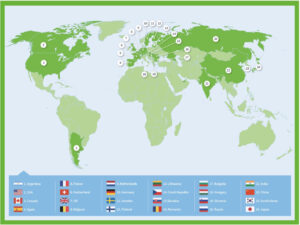As the Allerdale GDF Community Partnership continues the conversation about a potential GDF and whether this is right for the area, a number of countries – including Sweden, Finland, France, Canada and Switzerland – have already implemented or are developing plans for their own geological disposal facilities.
In Canada, developers Nuclear Waste Management Organization (NWMO) began the process of selecting a site for their project back in 2010.
A total of 22 communities initially expressed interest. Today, NWMO is engaging with two potential siting areas.
Technical teams from NWMO have successfully completed a full-scale demonstration of the engineered barriers that will safely contain and isolate Canada’s used nuclear fuel.
The map below shows the countries that are implementing or developing GDFs:

A historic decision
Meanwhile, the Swedish Government hasapproved the building of a GDF in Forsmark, Östhammar Municipality.
This historic decision means that Sweden is proceeding with plans for a GDF being developed by the Swedish Nuclear Fuel and Waste Management Company (SKB).
In Switzerland, Nagra (the National Cooperative for the Disposal of Radioactive Waste) will be ready to announce its siting proposal by the autumn.
In Finland, Posiva Oy is the first nuclear waste management organisation in the world to start final disposal of spent nuclear fuel by 2025, using the Onkalo® facility.
The developer’s view: why we need to think long-term
Neil Hyatt, the Chief Scientific Advisor to Nuclear Waste Services (NWS), said: “Technically, it is feasible to repackage the waste every few decades and build new stores.
“However, this is effectively kicking the can down a never-ending road.
“It would be leaving the cost, risk and responsibility of managing and safely disposing of waste to future generations who did not benefit from the energy generation.”
A GDF will be nearly 1,000 metres below the ground – more than half a mile. Expert engineering and many barriers of stable rock will safely contain the waste for many thousands of years.

